<> Catopsilia pomona (Fabricius, 1775) <>
the Lemon Emigrant ผีเสื้อหนอนคูนธรรมดา
Click on any photo to see all photos full size in Lightbox
Additions and corrections to the information provided on this page is always welcome. Please use the Contact form.
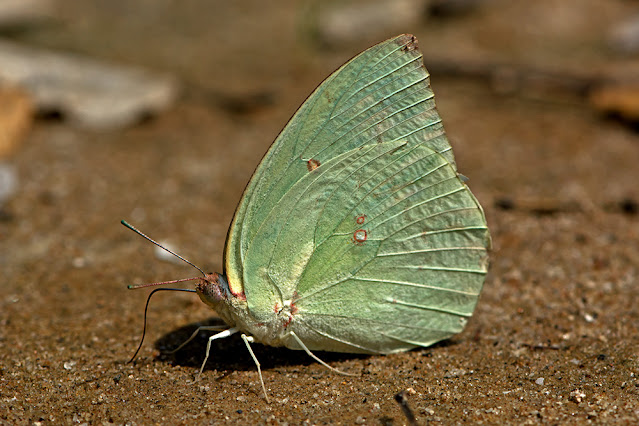
Photo taken at Doi Suthep-Pui National Park, Chiang Mai, Thailand ♂ 400m a.s.l.

Catopsilia pomona is common and widespread across the whole of the SE Asia region and beyond. It is quite a complex species with at least six different forms, each looking very different to the other. There is also considerable variation within each form, affected by both location and seasonal temperatures. Furthermore, the upper surface of the antennae in some forms is black and in others it's red. The most common of these forms is the male f.hilaria and the female f.pomona. The other forms are f.alcmeone(♂), f.catilla(♀), f.jugurtha(♀), and f.crocale(♀). Four of these forms are illustrated in the photos on this page. Most of the visual differences between the forms is displayed on the underside of the wings whilst the upperwings, rarely seen anyway, is simply white with variable submarginal black markings.
The species is somewhat migratory in habit and can sometimes be seen travelling in groups between low and high elevation breeding sites along the river valleys that they use as migration corridors. They are indeed very strong fliers, even reaching above treetops, in a pattern that is both fast and irregular. Both sexes puddle on damp ground and animal dung as well as nectaring on a wide range of wild and cultivated flowers. Although usually seen puddling singly or in pairs it is not unusual to see them puddling near streams in large numbers, especially during migration.
Being multivoltine and having a relatively short lifecycle, there are a number of generations each year. The adult female lays her eggs singly or in small batches on either the upperside or underside of a young leaf on the host plant. On hatching the larva eats the egg shell as its first meal before starting to feed on the young leaves. Around two weeks later it pupates by attaching itself to the underside of a leaf or the stem of the plant close to the ground.
Synonyms and previously used names: Papilio crocale, Papilio jugurtha, Papilio catilla, Papilio nigropunctatus, Papilio lalage, Papilio alcmeone, Papilio hilaria, Papilio titania, Catopsilia pura, Catosilia crocale, Catopsilia celebica, Catopsilia heera, Catopsilia pomona, Colias jugurthina, Callidryas endeer, Callidryas phlegeus + others
Taxonomy: Animalia - Arthropoda - Insecta - Lepidoptera - Pieridae - Coliadinae - Catopsilia - pomona
Regional subspecies: Catopsilia pomona flava (Indonesia), Catopsilia pomona pomona (most locations), Catopsilia pomona rivalis (Indonesia)
Regional Distribution: Nepal, Bhutan, India, Bangladesh, Myanmar, Thailand, Laos, Cambodia, Vietnam, China, Taiwan, Malaysia, Singapore, Indonesia, Philippines
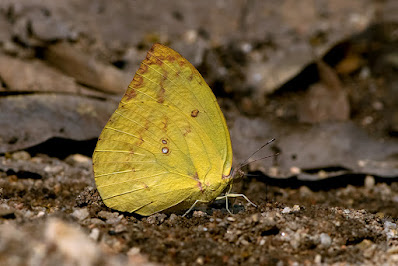 |
Doi Suthep-Pui National Park, Chiang Mai, Thailand ♀ 620m a.s.l. |
Habitat: Catopsilia pomona is found in a wide range of habitats including evergreen and deciduous forest, woodland edges, open grassland, agricultural land, gardens, parks, and wasteland. Seen at all elevations and has been recorded up to 3500m a.s.l. in the Himalayas.
Flight time: most of the year depending on location Wingspan: 50-70mm
Life History: egg 2 days instar 1 1-2 days instar 2 2-3 days instar 3 2-4 days instar 4 2-3 days instar 5 2-3 days pupa 6 days Total egg to adult 19-25 days
All times are approximate and can vary depending on the season and on the host used.
Larval Hosts: Bauhinia racemosa, Bauhinia variegata, Butea monosperma, Cassia bakeriana, Cassia fistula, Cassia grandis, Cassia javanica, Cassia roxburghii, Dalbergia latifolia, Gliricidia sepium, Phanera macrostachya, Pterocarpus indicus, Sesbania javanica, Senna alata, Senna alexandrina, Senna didymobotrya, Senna obtusifolia, Senna occidentalis, Senna siamea, Senna sophera, Senna timoriensis, Senna tora, Senna surattensis, Sesbania grandiflora (Fabaceae), Crinum asiaticum (Amaryllidaceae), Carissa spinarum (Apocynaceae).
Actual host plant used depends upon location and availabilty of plant species.
Adult Food Sources: Nectar - Duranta erecta, Lantana camara, Stachytarpheta cayennesis, Stachytarpheta indica, Stachytarpheta jamaicensis (Verbenaceae), Bauhinia variegata, Caesalpinia pulcherrima, Cytisus scoparius, Pterocarpus macrocarpus, Senna auriculata, Senna siamia, Senna tora, Tephrosia purpurea, Trifolium repens, Vachellia farnesiana (Fabaceae), Acmella calva, Ageratina adenophora, Austroeupatorium inulifolium, Bidens pilosa, Chromolaena odorata, Cosmos sulphureus, Galinsoga parviflora, Lipoblepharis urticifolia, Tagetes erecta, Tithonia diversifolia, Tridax procumbens, Xerochrysum bracteatum, Zinnia elegans (Asteraceae), Catharanthus roseus, Ichnocarpus frutescens, Nerium oleander (Apocynaceae), Hibiscus rosa-sinensis, Sida acuta, Sida rhombifolia (Malvaceae), Ziziphus mauritiana (Rhamnaceae), Coleus barbatus, Platostoma axillaris, Premna serratifolia, Vitex negundo (Lamiaceae), Ehretia aspera (Boraginaceae), Celosia argentea (Amaranthaceae), Asystasia gangetica, Rostellularia procumbens (Acanthaceae), Plumbago auriculata (Plumbaginaceae), Ixora coccinea, Oldenlandia corymbosa, Wendlandia coriacea (Rubiaceae), Turnera subulata (Passifloraceae), Oplismenus undulatifolius (Poaceae), Oxalis latifolia (Oxalidaceae), Solanum nigrum (Solanaceae), Ophiopogon intermedius (Asparagaceae), Tetrastigma leucostaphylum (Vitaceae), Zanthoxylum avicennae (Rutaceae), Syzygium cumini (Myrtaceae), Cyananthus incanus (Campanulaceae), Rhododendron falconeri (Ericaceae), Machilus odoratissimus (Lauraceae), Magnolia campbellii (Magnoliaceae), Aquilaria crassna (Thymelaeaceae), Bougainvillea gabra (Nyctaginaceae), Cardiospermum corindum (Sapindaceae). Other - mud puddling, animal dung
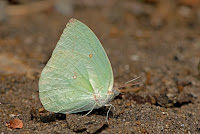 |
| f.hilaria Doi Suthep-Pui N.P., Chiang Mai, Thailand ♂ |
 |
| f.alcmeone Chiang Dao, Chiang Mai, Thailand ♂ |
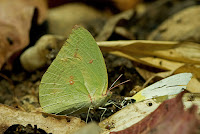 |
| Doi Suthep-Pui National Park, Chiang Mai, Thailand ♂ |
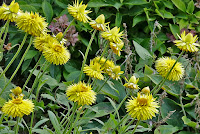 |
| Xerochrysum bracteatum, a nectar source |
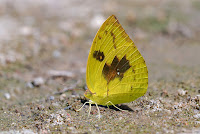 |
| f.catilla Doi Suthep-Pui N.P., Chiang Mai, Thailand ♀ |
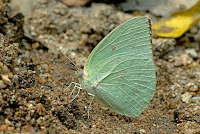 |
| Phnom Kulen National Park, Siem Reap, Cambodia ♂ |
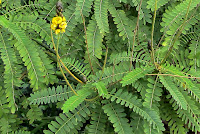 |
| Senna didymobotrya, a larval host |
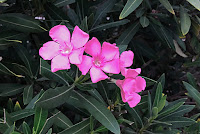 |
| Nerium oleander, another nectar source |
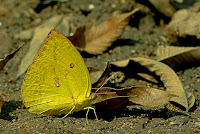 |
| f.pomona Doi Suthep-Pui N.P., Chiang Mai, Thailand ♀ |
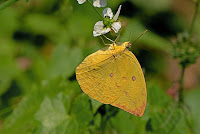 |
| Doi Suthep-Pui National Park, Chiang Mai, Thailand ♀ |
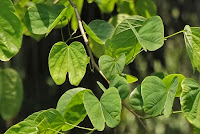 |
| Bauhinia racemosa, another larval host |
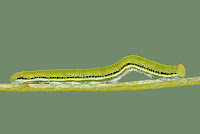 |
| late instar larva |
Links to other pages in this series for species in the same subfamily
